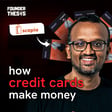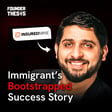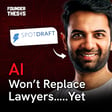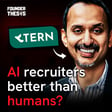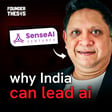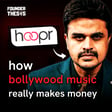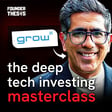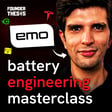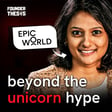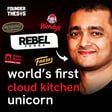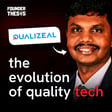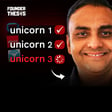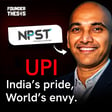Becoming an Entrepreneur: The Birth of R for Rabbit
00:00:10
Speaker
Hi, I'm Akshay. Hi, this is Aurabh. And you are listening to the Founder Thesis Podcast. We meet some of the most celebrated sort of founders in the country. And we want to learn how to build a unicorn.
00:00:26
Speaker
Often a person becomes an entrepreneur when he sees a problem that exists in the world and decides to solve it himself. This is pretty much what happened with Kunal Popat, the founder of R for Rabbit. When Kunal became a father, he realized that India just did not have the kind of high quality strollers and other baby care that he was looking for.
00:00:45
Speaker
And instead of accepting the problem and trying to import something for his daughter, he decided to just go ahead and build it himself.
Building a Brand Against the Odds
00:00:54
Speaker
Even though he had no experience in manufacturing or marketing or branding or sales, he just went headlong into it with nothing more than Perseverance and Optimism. Today, that Perseverance and Optimism has paid off. R4Rabbit produces some of the most popular brands of strollers and write-ons for kids, and they also raised the $5 million funding last year.
00:01:15
Speaker
Here's Kunal talking about how that whole journey began.
Identifying and Filling Market Gaps in India
00:01:18
Speaker
You know, when my daughter was born, as I used to travel internationally, day in, day out, 15 days I was out of, you know, country, regardless of the month. So, you know, when you have your first child, you always wanted to give the best.
00:01:34
Speaker
So I couldn't bring a lot of big items from outside like in a stroller or car seats or high chairs or craddles. I had to buy it from India. I used to buy a lot of small stuff like rash creams and all because there were very less rash creams available at that time. Good quality. Okay. So you can bring those. Which year are you talking about? I'm talking about 2012. Okay. Okay.
00:02:04
Speaker
So at that time, there were only two, three companies in India, and then there were international brands all level in India. So whenever I used to buy, I liked international brand quality, but the price was quite high. If you want to get a good store, you have to pay 18,000, 20,000. And as a Gujarati, you see value in everything.
00:02:30
Speaker
So, I thought, you know, I need a good quality, but I cannot pay it in 20K. It's not that I cannot afford, but I don't want to pay, you know, this is much more than a standard Indian can buy. And there were other domestic brands where the quality was extremely pathetic.
00:02:48
Speaker
And being always exposed to the international market for the last few years, I used to learn about standards. What are the standards of safety? Because, you know, international, all the countries work on standards. There are always standards for everything. So when I get my first child, I used to say, OK, what are the standards for credit? What is the certification for credit? So I couldn't find any certified product. I couldn't find any safety certified stroller, which has gone through those safety standards.
00:03:19
Speaker
So I struggled to get the right product at the right price for my daughter. So note how I had to compromise and pay high to get international quality. But that always spins the wheel. This is not something right. Either it's too cheap, no standards, no bi-domestic brands, or international brands are selling too expensive.
00:03:42
Speaker
So there might be many parents like me who wants to give their child the best,
From Idea to Execution: Overcoming Manufacturing Challenges
00:03:47
Speaker
okay? Who wants to give their child safety certified products? Who wants to give their child international card? But their budget is, we all Indians, you know, we know the value of money more than Europeans or Americans. So value for money was the thing, you know, where I found that it needs to be safety certified and standard, but it has to be a right value for a parent to
00:04:13
Speaker
afford so that it doesn't pinches. So that's how you know I started the journey of entrepreneurship like a thought was born in my mind that okay this is the white space that I want to enter.
00:04:27
Speaker
And it took some time to enter, but gradually we started step by step and we entered into... So tell me about that journey from idea to execution. Like you had an idea, okay, there is a need for baby products in India, which are of international standards. So how did that idea get executed? So initially, you know, as an entrepreneur, you always wanted to build first in India. Okay.
Pivoting Business Models: Manufacturing to Online Sales
00:04:56
Speaker
So I started to create a product for the first product that I created domestically in India was Cradle and Creep, which was a unique design, 4-in-1 product, which can become a cradle, which can become layered, which can become creepy as well. It was conceptualized in India. I tried to develop in India.
00:05:22
Speaker
Sometimes when you create and vision a product and when the real output comes, it's different. So design and practicality, the finishing that I can get from the Indian vendors was not up to the international standards. The technology was missing, the plastic components that I wanted. There was no ecosystem of BB products.
00:05:48
Speaker
Everything you cannot develop here, you need to get few parts from the ecosystem. So the ecosystem was completely missing and because of that, what I envisioned that the product will be and what it really came out, there was a difference. We tried to push it, like you know, the product is by the way patented, design is patented. Okay, we filed for a patent at that time.
00:06:15
Speaker
But how did you design? Because you don't have designing skills. I hired the best agency who used to do the product development only. Engineering company. And this was while you were still working or you had quit your job? I was still working because I couldn't afford at that time to just leave the Germany.
00:06:38
Speaker
So till the product was conceptualized out, I wanted to work. So it was all night hours, you know, weekends, night hours, weekends, night hours. You spend, there is no seven, eight or nine hours that I have worked in so many years.
00:06:53
Speaker
So that's how the journey was started. But ultimately, I realized after selling to the market that this product will not scale up to the level that I thought of. How did you get the first few sales? Like you found a contract manufacturer in India, and then you got a few pieces, maybe 100, 200 pieces delivered. And then you like, tell me how did you go about doing that?
00:07:19
Speaker
So, it was, you know, like I found the contract manufacturer, we created some 400, 500 PCs.
00:07:29
Speaker
Initially, I asked him for delivery of 100. I didn't have the warehouse. So I said, okay, to my home and one room was packed with so much product. And how did your wife react to that? I would say that, you know, I'm lucky and fortunate that she always supported me. Okay, so she used to understand my always the vision that I want to become an entrepreneur.
00:07:56
Speaker
So many times I used to share an idea before I started that, you know, I want to do this. I want to. So she understands, understood me very well. So she supported me because I was working. We listed the products on Amazon. We started selling. We listed on at that time the first cry was new. So we started to sell in first cry. So she was the one who started to work with me as a co-founder and run all the operations for the company.
00:08:26
Speaker
So initially it used to be from my home. Then, then, you know, it was time for me to pivot the business and say that, OK, I have to change the product. And that's how. And how were you selling it? Was it through Amazon and Flipkart? Yeah, so it was an online sales through website. So that was the main channels that we started.
00:08:47
Speaker
And then it was time for me to think that this product has a limit for scaling up. And even as a founder, you see that this should not be there. This should not be there. This finish can be better because when you always see international quality, you itself as a founder, if you are not happy, sometimes you have to take the hard calls.
00:09:09
Speaker
So I already invested 15, 20 lakhs at that time to create the conceptualize the product from ideation to finalization and production. I said that, OK, it's time for me to hard call. Let's discontinue. OK, so we stopped the product and we voted the business model and we said that, OK, as I wanted the best for my child, OK, let's get it.
00:09:38
Speaker
And I would say let's customize it as per the Indian test, the international standard safety certified products. So that's how we started to get into the baby gear business. We started with strollers and carry cotton, three, four items.
00:09:57
Speaker
When did you quit your job?
Expanding Product Lines and Business Commitment
00:09:59
Speaker
Like when did you get into it full time? Was it after you decided to pivot? Even after I decided to pivot, even after I started to get the ball rolling one and a half years.
00:10:10
Speaker
So after computing, I worked still for one and a half year to validate that what I was doing was right. And Kinjal managed my wife. She was handling the operation. So she managed the operations. And I used to be at the back end conceptualizing and telling, guiding her that, you know, talk to this, we have to do this. So this is how, you know, step by step we started the journey.
00:10:39
Speaker
What did you pivot into? Like initial model was to design and build in India, then what did you pivot into? Design in India produced outside India. Okay. So you got it like from China? Yeah, exactly. So China, Taiwan and other countries where the ecosystem was very strong.
00:10:59
Speaker
But then the ecosystem of any product that you want to launch has to be strong so that you can be the great products because a lot of components you can source from third party. You cannot create everything on your own. There are so many components in a stroller. So if you said that I want to produce wheels, I want to produce bearings, I want to produce this, it will take time to launch a stroller.
00:11:24
Speaker
but if you say that you know this is the type of fabric like even I couldn't get the fabric okay oxford fabric is generally used in strollers and high chairs and car seats and all you know oxford fabric is not what is oxford referred to it's a fabric a type of fabric okay it's not polyester it's not a cotton it's it's a type of
00:11:48
Speaker
it's a main main fabric which is different which has got enough strength and all and there are deniers you know ex-denier fabric you can you cannot source this from India you can get this some of the colors but that too it was imported from China only so the options were very less so even the fabric you couldn't get it in India so that really you know frustrates you that you know there is no ecosystem in our country so big country
00:12:15
Speaker
So there was no option but to you know that okay let's get into a place where there is an ecosystem and design the products ourselves and get it manufactured by someone where there is ecosystem. And you continued with Stroller as your product or like did you expand into other products also? So initially we just started with four products. One was Stroller, one was Caricot,
00:12:44
Speaker
At that time, I was so fascinated that we launched mini washing machine. I saw that everywhere, when a child is born, their clothes are washed separately. Because it's soft, it's dirty. It doesn't get mixed with hygiene. It doesn't get mixed with the other clothing.
00:13:10
Speaker
So at that time I said that you know let's launch mini washing machine just for babies. Okay so that was one of the product after you know sometime we thought that if we are you know we have to we are not ripe for this ecosystem because it for having 4000 rupees or 5000 rupees washing machine people were expecting us to bill your service at home like you know you buy LG or Samsung washing machine.
00:13:37
Speaker
So that is not possible. So that is not something, you know, we could send the parts, we could send, we could give them a remote supply, remote support, but it was not possible for us to, you know, give a home service to people. So the expectation of customer is coming from, you know, the bigger version. So we discontinued after some time, after a couple of years. But those were the end one was Walker, baby Walker.
00:14:05
Speaker
So that's how we started with both products. And step by step, we got the success fortunately. How much sales did you do initially, like first year of business? How much did you sell? So we started in December 2014 to do real sales. And I remember that hardly we touched, I think, in 78 lakhs in those financial year.
00:14:36
Speaker
So then people started accepting the products well because we were able to hit the right pain points which I as a parent used to always find and we tried to solve those pain points. And that's how sales was very good at the second year and it got even better.
00:15:00
Speaker
How did it grow? Like what was second year sales? What was third year sales? The second year sales, if I can recall, it was around 1.6 year. Then it went around 3.6, then 7.2. Okay, well, you're doubling. Yeah, so then 18.5.
00:15:21
Speaker
then 36, so every year we used to double. And what was the sales like when you quit your job, when you felt, yes, this will work, like when you got that confidence? 3.6 years. So, you know, there were no profits, like, you know, you hardly make money when you do 3.6 years since. But, you know, you can still feel like it's time for you to take the call. You cannot run the business like this.
00:15:48
Speaker
So then I took the call and came full time. It was... And which year was this? When you came full time and... If I can recall, it was 2016. Okay.
00:16:03
Speaker
If you like to hear stories of founders then we have tons of great stories from entrepreneurs who have built billion dollar businesses. Just search for the founder thesis podcast on any audio streaming app like Spotify, Ghana, Apple Podcasts and subscribe to the show.
00:16:25
Speaker
And then like it continued through Amazon and Flipkart or like what was your sales channels like from 3.6 to 7 when you went like when you doubled that year, was it all through Marketplace? Yeah, mostly it was through Marketplace but from the day one, you know, after once we started to stabilize the operation, we started to build channels.
00:16:46
Speaker
So we had a distributor channel in place. We had just two, three guys of sales, sales guys in place. So whatever sales guy, sales team used to do the numbers. So we expanded to Gujarat, then to Mumbai, then to Rajasthan, started working with some of them. And these would get supplied to like baby products. Exactly. Baby products. Like the organized ones, like say mom and me and
00:17:12
Speaker
First cry types are like unorganized.
Doubling Sales and Adapting During the Pandemic
00:17:15
Speaker
So, at that time, the sales team generally works with unorganized stores. When you are small, you cannot expect that organized retail will accept you. It's a bigger factor like that. Only once you grow to some extent, they will show the acceptance. So, it was all small, small baby stores who used to give us an opportunity.
00:17:39
Speaker
And that's how we started. But I, you know, at that time as well, the majority of the sales, you know, 80 percent of the sales was coming online by a market basis. OK, OK, OK. So by 2020, what volume you must have been like at the 3035 CR mark around 2020. Yeah, by 2020, yes, we had like before in the year of 2020. So by
00:18:10
Speaker
you can say for 1920 we did 56 here and this is again 80% online 20% offline yeah like 70 like you then you had first cry as well first cry is a different business model so first cry is online offline both so we consider you know everything
00:18:35
Speaker
Under one and distribution retail in others. So along with first cry and online market basis. It was still 18 75 80 percent address for them Okay, okay, so Did the pandemic affect you would either negatively or positively? It affected both the negatively
00:18:59
Speaker
In terms of the entire supply chain was disrupted and now still now, you know, it's disrupted. So the cost of logistics, the cost of inter-country travel, a lot of things affected us a lot.
00:19:16
Speaker
So we had to pass through that shocks. Lockdown was another shock that you have a huge stream and you have zero revenue for two months. You don't know how to manage cash flow. And you had so many containers lying on the port and no one pays you. Okay. In COVID, everybody stopped paying to impact. Yeah. Yeah. Yeah. It was very tough time. Honestly, very tough time to pass through.
00:19:45
Speaker
Did you fear that you will have to shut down? Never. Did that fear come? Never. We understand that it's pain. You have to pass through that pain. It is going to there for some time. But it was not like closing down the operations. I never had even a thought that I will close down.
00:20:08
Speaker
Yeah, we always expect that we don't know how much the sales will rebound. It's gonna be tough time to once again get back to run trick. But you know, it's not about closing down.
00:20:23
Speaker
Okay. And so this 2021 financial year, then what did like did the sales bounce back? Did you cross 50? Yeah, like was it? So no, no, we and as I said, you know, it affected negatively and positively, positively because a lot of customers change the habit from offline to online. And we were there in all the online places, which is available options available in India.
00:20:51
Speaker
So that was a positive aspect for us that we could tackle it very well. And it helped us to survive faster. And it helped us to bounce back as well. So even in the 21, we did 67. So we surpassed the number that we did last year. What is your estimation for your top line in the 21-22 financial year?
00:21:22
Speaker
We want to be as close as possible to century. Wow. Amazing. Amazing. OK. OK. So you initially invested that 15, 16 lakhs of your own money. And subsequent to that, did you keep investing your own money, or did you raise funds? How did you finance this? It was all a good start till we got the first run. There was no seed funding.
00:21:49
Speaker
because all the funds coming from myself, family and friends and families. So we keep on investing and then you get a small credit line from bank, you get a small credit line from NBFCs. So that's how you keep on funding the growth. But then at that time, you have to take a call that it's time for you to get more money to have a faster growth.
00:22:20
Speaker
So at that time. What is the way in which you decided that, OK, now I need funds? Tell me about that thought process when you decided to raise funds. And how did you go about raising funds? So initially, it was a bootstrap business. And as most of the businessmen thinks that you are very much responsible when you have an external capital.
00:22:48
Speaker
It's not just responsibility, but it's a responsibility about returns. It's a responsibility about a lot of you know things so Sometimes you try to say that I can avoid one year two year three year as much as you can Then in probably you know January
00:23:10
Speaker
We thought that the brand is getting sufficient traction. The numbers are looking great. We can scale up to the next level. We want to get into categories which require more funds. So it's not possible. It's never going to be possible with the internal accureals and all. You need more funds and banks because they had their constraints of lending. They will not support.
00:23:37
Speaker
So, Dad gave us a thought that it's time for us to let's start and go to the market and pitch the idea of raising money. So, we hired an investment banker. This is January 2021. January 2021. So, we hired an investment banker, Deloitte, and he helped us to get in front of many investors. We pitched to many.
00:24:06
Speaker
Some were funding, some were not. And finally, we were able to raise the funds enough. So what made you choose an investment banker and not directly go to VCs? I mean, most VCs will respond to an email from a founder, especially a founder who already has a top line of 50, 60 CR. So what was the advantage of going through an investment banker?
00:24:37
Speaker
I have to accept strength and weakness of mind. When you are an entrepreneur, you are an engineer, you don't understand some of the investment theories, philosophies, thought process, the jargons that they use. When you have an expert with you in this,
00:24:59
Speaker
they coach you, they tell you like someone asked me you know 10 year projection okay I can prepare an excel but that is not sometimes that they want to see on the cash flow front on the balance sheet front
00:25:13
Speaker
You need to have an expert who tells you this is the way it looks like, this is how it goes in balance sheet and cash flow and this is how your actual business plan will look like. So I needed an expert because I am an engineer, I am not coming from an investment background. So we thought that an investment banker will help us to get the things right in place.
00:25:37
Speaker
and we'll share his experience. What are the processes through? What are the standards of investment? Sometimes someone tells you terms and condition. You said, how can you tell this? But it's an investment standard. Every startup accepts this. So who will train you for this? So investment banker helps you. No, no. Punal, what they are asking is logical. The logic behind this is this. That's why they want security. That's why their food is closed.
00:26:06
Speaker
So you always go with the experience of the people and learn from that. OK. And I think you raised runs from Exponential Capital Partners. Yes, exactly. So why did you choose them? And they're not like a name I have really heard much about. So why not like more names that everyone hears about?
00:26:34
Speaker
Why? It's a nice question. Sometimes you go with an investor where you see the fine tuning of your minds. I'm a traditional entrepreneur.
00:26:53
Speaker
So the numbers, the fundamentals matter more. Then just top line and this new age businesses where you constantly burn and you wait for the cash flow to become positive one day. So sometimes you have those differences with the investors that you want to have a sustainable
00:27:21
Speaker
in a scalable and a fundamentally strong business, which obviously wants high growth, every investor wants high growth, but the fundamentals has to be respected. So, exponential partners, their partners were coming from the same theory, same background.
00:27:38
Speaker
They want a fundamentally strong business who also understands the value of money, right spend at the right time, getting into the, do a lot of homework before getting into any category. Do everything has to be well researched before you get into. So a lot of principles were very match. We were able to correlate with each other.
00:28:04
Speaker
And with some investors, you see that aggression. OK, don't think about this. Just go on. Just go on. So that made us to go with an investor where we were able to have a like mind. Got it. OK. And what do you intend to use these funds for? What are the categories you want to enter? What are the categories you are currently in? And what is the plan now? How do you plan to use these funds?
Venturing into the Baby Care Segment
00:28:34
Speaker
So basically, we are into, you know, baby gear, ride-ons and feeding and nursing category, which are the major three categories. So baby care means like rash creams. No, no, baby gear, gear. Okay, baby care. Gear is taller, car, six height, chest, carriers, ride-ons and feeding and nursing where we just entered. Okay. These are the major categories and we want to enter into baby care category, care segment of the baby.
00:29:03
Speaker
And so, most of the funds will be deployed to get into the more consumables and, you know, the FMCG products of the baby. All the products... Like diapers and... Yeah, yeah, yeah, yeah. Exactly, exactly. So, all the products that we have right now is one-time buy. There are no refill buys. Right, right, right, right. Okay.
00:29:27
Speaker
And all the products you sell right now are like your own brand or do you also sell other brands like as a distributor? Okay, okay, okay. So this seems pretty high risk like the category you now want to get into like diapers and rash cream. I mean you know on the one hand you have like say Bama Earth kind of companies in the that rash cream and that segment and then
00:29:52
Speaker
in diapers also, like I think first cry and all have their like private labels and so it's like a very crowded category that you want to get into. What makes you feel confident about getting into this category? You know, I would say every business is competitive. Everywhere there is competition. Tell me one business where there is no competition.
00:30:21
Speaker
No, but like what you identified as the gear for and you know, like international standard that did not have it was not a very crowded category. But this category, which you're getting into now is like a lot more crowded than that. So comparatively, it's a more crowded category. So, you know, what is the I mean, what is the lever because of which you think you'll do well here?
00:30:48
Speaker
So what I understand as a businessman is everybody is doing business. Everyone has their own space. You have to get your wide space. Where you become very strong in specific segment in that particular category.
00:31:07
Speaker
So we, you know, as the funds will be deployed, we are doing our research now, okay, on baby care categories. Where is that wide space? Which are the pain points, okay, to be addressed? What are the right norms of the customers to hit? Okay, so whatever category we have been entering to, let's say it was, you can say that, ah, yeah, it was not dominated like stroller or car seat, we're not dominated.
00:31:33
Speaker
But you had a lot of competition from Chinese imports and every other guy imports from China. Unbranded products. So you still had a lot of competition. You still had a lot of domestic and international brands competing with you. Bigger brands like Kikro and all. Still we were able to get our space and we are doing a decent number in every category. Bicycles.
00:32:03
Speaker
How many bicycles companies are there in India? How many unbranded and branded? We still entered into this category and we have our own space where we do a decent volume and people love our bicycles, kids bicycles, three to five years and all. So we identify the right white space in that particular category and do our research properly and then enter.
00:32:28
Speaker
So if you ask me, what are we going to do? So we are in still research phase. So this 100 crore that you're expecting this year's top line, what is the split in terms of categories? All the existing, everything will be coming from the existing categories.
00:32:44
Speaker
No, no, but like split, like how much from say bicycle category, how much from the stroller or like what are the major contributors? So generally, you know, baby gear is the major contributor, baby gear in ride-ons. So 60, 60% coming from baby gear, 30% coming from ride-ons, 10% from rest of those categories. What do you mean by ride-on?
00:33:09
Speaker
Ride-ons is tricycles, bicycles, kicks, footers, you know, all that particular part of, so where child can ride, okay, screencars. Generally, it goes with gears. Okay. And how much of the sale is from your own website versus how much from marketplaces? So we are still, you know, trying to build that.
00:33:37
Speaker
momentum from yeah so currently it's contributing less percentage in the total but the next you know as we have said that the next the funds will be used to grow the sales from the own website and making the brand much more stronger so the technology implementation the new is going on we are in that process
Strategic Marketing and Cost Management
00:34:03
Speaker
So I've heard this, that most D2C companies pay a very significant chunk of their revenue to Google and Facebook for ads to acquire customers. That customer acquisition cost is pretty high in the D2C space. What has been your experience of that? What has been your customer acquisition cost? And how do you acquire customers?
00:34:30
Speaker
so you know the platforms are the same okay but it's how disciplined you are how smartly you play okay so i agree with all the d2c founders that the cost of customer acquisition is high but there are always optimum level that we believe after that there is a waste okay we always work and try to be at the optimum and spend only to that level where we see the returns
00:34:59
Speaker
too much of visibility, you know, because we were bootstrapped till now. So we always wanted to maintain that balance. And so we worked smartly, we worked only on the time where most of the customers are browsing the products and buying happens. So you control and push your spends based on the time you control and by time, you mean time of the day, time of the day, time of the day. Okay. Okay.
00:35:25
Speaker
So you like you know, you know that maximum conversion happens up in seven between, you know, 7pm to 12pm. And the maximum conversion happens in the morning hours. Okay. So this is the time you have pushed your funds, really push your ads. Okay. Then you slow down because you may get the clicks, but there is intention of buyer conversion chances very less. So you have to optimize. We had very limited funds as a bootstrap company.
00:35:55
Speaker
So we always use hacks and tips and tricks. We learned and optimized our spend. What is your monthly spend, like monthly ad budget? Right now it's around 40, 50 lakhs a month. And where is it split? Like how much on Amazon and like, which are the channels which you prefer to spend on? Yeah, our preferred channel is wherever there are customers.
00:36:25
Speaker
wherever there are conversions. So if we see more conversion on Amazon, we spend more on this. If we see more conversion on Google, we spend on that. So it depends wherever the customer is intending to buy or we should be there.
00:36:40
Speaker
OK, so it's like dynamic, like it changes everyone based on what you are seeing. Exactly. So wherever we see the high conversion of buying, we push our accelerator to that marketplace or the advertisement space.
00:36:59
Speaker
Got it, amazing. Yeah, I think you've kept your ad spend very much in control, like 40, 50 lakhs and your monthly turnover must be some between seven to eight CR kind. So it's a pretty small percentage of that. Yeah, so we can, that's what I said that, you know, how much you spend and how much, how optimum you can. Now, obviously we were conservative because we didn't have much funds to deploy.
00:37:26
Speaker
Now, step by step, we'll ramp up our funds for brand building. So most of the funds are in performance marketing. We never pushed the funds to create, push for the brand marketing. So now we... Influencer marketing or celebrity marketing? Exactly. Influencer, we used to do one and a half, not too much. But as you rightly said, influencer marketing, celebrity marketing, pushing a lot of videos, a lot of
00:37:56
Speaker
Just for brand where you don't expect much sales, but you expect that you know people see your brand very well, right? So we only spent in the performance part till now And what kind of margins do you have on on this like
00:38:14
Speaker
we have you know unfortunately our margins are much lesser than the consumables or care category or any other you know need to see companies that have so okay why is that like the industry it's the industry metrics
00:38:33
Speaker
So like diapers, rash cream, these have better margins. So that's also one of your reasons to get into that, like to improve margins. Care has better margins, not the diapers.
00:38:46
Speaker
Yeah, right, right, right. Your diaper is more like a customer acquisition cause like how most Kirana stores have milk as a way to get in customers, but milk doesn't have much margin. So I think diaper is something like that. Like it's just a way to get in a customer. So diapers as a category don't have great margins, but yes, the shampoo, oil, creams, you know, the care category have a good margin.
00:39:16
Speaker
And so, you know, what's the roadmap of, say, 2025? Like by 2025, where do you see R for Rabbit? We want to become what our taglines is, amazing baby company. OK. But like in terms of what some numbers, like what kind of top line do you think you'll hit by then or? You know, top.
00:39:44
Speaker
everything there are always numbers that you place on a business plan okay. Ultimately what you want to achieve is be in the top of the mind of your consumers in any category that you enter okay. So what we want what our fundamental says is in any category that we enter we have to be in the top three phases of the customer okay. So we want to get to that level where any category we go we are in top three phases of the customer.
00:40:14
Speaker
So whether that leads to revenue X or revenue Y, that's a different story. But the fundamental is this. Right, right, right. So tell me about this name R for rabbit. What is the genesis of that? So actually, when I had my first channel,
00:40:37
Speaker
The business, entire business is inspired after she was born. I could see the opportunity after she was born. I couldn't see this opportunity before she was born. So I always wanted to have that connect. Sometimes you just want to get connected with the source, where it started. So at that time, when my
00:41:04
Speaker
daughter was born. She used to love the software of Rabbit. She used to sleep with that. She used to love that character a lot. And I wanted to connect with the source. So I decided, OK, we have to coin the name. Let's think about this.
00:41:32
Speaker
So when you think a lot of things, when you wanted to still have a connect and you wanted to have a brand where just the name can also say a lot of things, okay, that what this company might be doing. So after a lot of iteration, you were able to see that, okay, I am able to fulfill all these requirements of my, you know, having a source or my daughter somewhere getting connected, you know, the inspiration that I got.
00:41:59
Speaker
you wanted to have a brand name which is unique and which also brand name says a lot of things so and you wanted to have a name which is unique in the world okay in a international trademark dictionary there should not be such name existent okay so anywhere any part of the world someone searches are for rabbit like you know someone searches the name it has to be us only
00:42:27
Speaker
.com should be available. Yeah, all those aspects. So we found this rhyming word and that was unique.
00:42:36
Speaker
which fulfilled all the aspects when I started to think about a brand.

